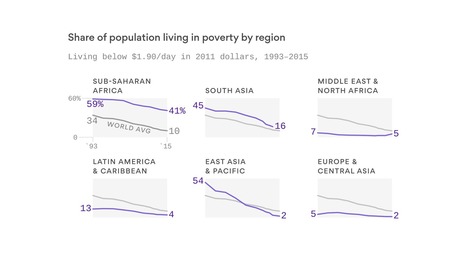Only 10% of the world's population in 2015 lived on less than $1.90 a day.
Get Started for FREE
Sign up with Facebook Sign up with X
I don't have a Facebook or a X account
 Your new post is loading... Your new post is loading...
 Your new post is loading... Your new post is loading...

Brian Weekley's curator insight,
July 27, 2016 10:47 AM
Great simple map of world population. Scroll down and look at the U.S. It reflects the global trend. This also has political implications, as evidenced by voting patterns in the 2012 presidential election. Elections are dependent upon votes, which come from people, which are primarily clustered in cities. Election campaigns would use this data to plan their schedules as to where to focus their campaigning efforts. For the folks in Wyoming, they rarely see candidates other than during the primaries. And these world populationclusters have been relatively consistent historically, particularly in south and east Asia. Northern India has serious carrying capacity challenges. Notice the clusters along the Nile- evidence of arable land.
Gene Gagne's curator insight,
December 1, 2015 7:37 PM
Lets not forget the expansion of china also with its economic strength and its military strength which is a threat to other countries in the area because china can take control and with Chinese moving into Africa and United states as residents china is going to need to populate its own country.
Adam Deneault's curator insight,
December 14, 2015 8:55 PM
First implemented in 1979 and diminished in 2013 It is good to hear something like this has finally come to an end. Although it deemed successful by stopping the birth of an estimated 400 million babies, there were some places that allowed two children in rural areas if the first was a girl. It is assumed though that even though this is no longer a required policy, many couples may only have one child since it is accepted as a social norm.
Stevie-Rae Wood's curator insight,
December 9, 2018 8:42 PM
China enacted a one child policy in hopes of controlling the overpopulation problem in the major cities. It was not a strict law per say that you would go to jail if you had a second child, you got tax breaks if you managed to only have one child. The one child policy ended up working and because of it there are 300 million less children than if they did not have this policy. However they stopped the policy because of the problems that the future generations and rural families faced. The one child policy was bad for rural farmers because they needed more than one child to work the land or work in general to help support the family. There was also a surplus of males because of the ultrasound, the females were usually aborted because makes are seen as more valuable. As well one child will also be burdened with taking care of all there elders, which is costly for one person.

Garry Rogers's curator insight,
October 31, 2014 7:59 PM
Good. This is long overdue. Reducing the human population by encouraging birth control will take generations. In the short term (like in the next five years), we must drastically reduce greenhouse gas emissions and we must gain control over land use practices. |

Garry Rogers's curator insight,
December 19, 2015 6:58 PM
GR: This is a well-written review of an excellent book on population. For Earth: We need to act now to stop greenhouse-gas emissions, and we need to act now to begin reversing our population.

Garry Rogers's curator insight,
January 25, 2015 2:25 PM
Good. We need more like this. We need to delete the third-rail image from population and bring public pressure to bear on our politicians. 
V. C. Bestor's curator insight,
January 26, 2015 11:25 AM
Ladies devoted to Creation can save species from humans: the Garden of Eden has elbow room for all God's critters.

Colleen Blankenship's curator insight,
October 12, 2016 8:51 AM
After reading this article, do you agree or disagree? Remember, be specific with your arguments.

Colleen Blankenship's curator insight,
September 5, 2018 10:01 AM
How will this trend affect perspectives on population? How will the DTM reflect these new figures? |


























